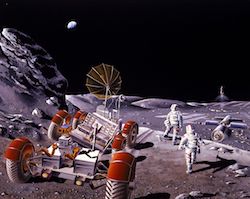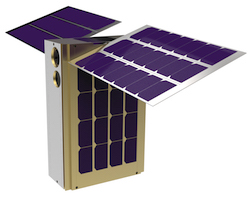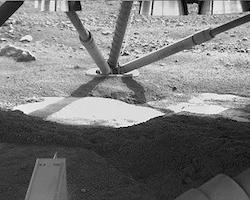
Searching For Resources Off-World
We still have much to learn about the space environment before we can expand permanently. Exploring the planets has been the first step to living in space forever. Now we need to survey space for materials that we can use to survive.
 As we travel farther from Earth, it will make more sense to collect resources for life from wherever we go. The cost of bringing supplies from Earth becomes very great as you get farther away. Future astronauts will also need to be farmers and miners. We will need to grow food, collect water, and mine rocks. These will be used to produce air to breathe and rocket fuel to travel. We can also use rocks and minerals to build bases. Future human colonies will need to be able to provide all of their own resources.
As we travel farther from Earth, it will make more sense to collect resources for life from wherever we go. The cost of bringing supplies from Earth becomes very great as you get farther away. Future astronauts will also need to be farmers and miners. We will need to grow food, collect water, and mine rocks. These will be used to produce air to breathe and rocket fuel to travel. We can also use rocks and minerals to build bases. Future human colonies will need to be able to provide all of their own resources.
Arizona State University (ASU) is contributing to the search for resources on other planets. For example, the Lunar Reconnaissance (ree-con-uh-sense) Orbiter Camera is based at ASU. It regularly provides a map of the Moon’s entire surface. These maps are used to find areas on the Moon where water ice may be found and mined.
 In a few years, ASU’s LunaH-Map spacecraft will make measurements that indicate where and how much ice exists at the south pole of the Moon. In combination with the pictures taken by the LRO Cameras, this mission will allow us to make even better estimates of the amount of water on the Moon. This will let us make informed decisions about where to build future bases.
In a few years, ASU’s LunaH-Map spacecraft will make measurements that indicate where and how much ice exists at the south pole of the Moon. In combination with the pictures taken by the LRO Cameras, this mission will allow us to make even better estimates of the amount of water on the Moon. This will let us make informed decisions about where to build future bases.
The Moon is not the only place being considered for a future base. Mars, the third planet from the Sun, offers the next closest location. Mars has a similar day length to Earth, a lot of water ice, and a thin atmosphere. NASA’s next Mars rover, named Mars 2020, will carry a device to create breathable air out of Mars’ atmosphere.
 Missions sent to orbit and land on Mars have shown that ice exists at some places within just a few inches (~10 centimeters) of the surface. This could be a great resource for future bases on Mars. They may provide more than enough water for future humans on the surface.
Missions sent to orbit and land on Mars have shown that ice exists at some places within just a few inches (~10 centimeters) of the surface. This could be a great resource for future bases on Mars. They may provide more than enough water for future humans on the surface.
The great adventure of space exploration is now upon us. In just a few decades, we may be living on other planets in the solar system.
Additional images via Wikimedia Commons. Image of Neptune by NASA/JPL-Caltech/Kevin M. Gill, from Los Angeles, CA, USA.

Neptune's atmosphere is mostly made of Hydrogen and Helium, making it a potential planet to mine for gases to convert to fuels.
Be Part of
Ask An Earth and
Space Scientist
By volunteering, or simply sending us feedback on the site. Scientists, teachers, writers, illustrators, and translators are all important to the program. If you are interested in helping with the website we have a volunteers page to get the process started.
